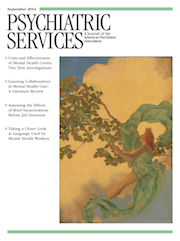There are 3.4 million rural veterans enrolled in the U.S. Department of Veterans Affairs (VA) health care system, and 32% of veterans of conflicts in Afghanistan and Iraq (Operation Enduring Freedom, Operation Iraqi Freedom, and Operation New Dawn [OEF/OIF/OND]) return home to rural communities. With a shortage of mental health professionals in rural areas, these veterans face significant disparities in accessing care, especially specialized services. Although telehealth is a somewhat successful strategy to address this disparity, geographical inequities in the distribution of mental health professionals are unlikely to change in the near future.
Up to 13% of OEF/OIF/OND veterans have combat-related posttraumatic stress disorder (PTSD). Despite the availability of evidence-based treatments, these veterans are less likely than veterans from previous eras to seek outpatient treatment and are prone to prematurely dropping out of PTSD treatment. There is a pressing need for innovative interventions that focus on enhancing the reach of PTSD treatment.
Peer support for PTSD may represent such innovation. A peer support provider is someone who has personal experience with PTSD, and having attained significant improvements in his or her own condition, this person offers formal services and support to peers considered to be not as far along in their own recovery process. The peer support provider is a member of the mental health team who shares and self-discloses personal experiences with PTSD; specifically, the provider focuses on skills, strengths, supports, and resources he or she has used. Although the use of peer support to provide services to individuals living with serious mental illness has been well investigated, the implementation of the intervention for individuals with PTSD is a recent concept. We hypothesized that peers could play a key role in augmenting PTSD care offered by overburdened mental health professionals to help engage veterans with PTSD in treatment.
This report describes the Peer Support Program, a clinical demonstration project for veterans with PTSD and substance use disorders living in rural California. In early 2012, we developed the program at the Sonora clinic of the VA Palo Alto Healthcare System. Program leadership and direction came from the Menlo Park Division campus, which is 130 miles from Sonora. Most veterans seeking services at this clinic are male and Caucasian, and the average age is 61. The most common primary diagnosis at the Sonora clinic is PTSD, and 20% of veterans have a comorbid substance use disorder.
An important first step was to recruit the peer who would provide services along with the clinic’s mental health team of five. We used rigorous screening and hiring procedures. Our top priority was to ensure that the peer received adequate training for the position and was able to demonstrate certain competencies. We selected a veteran with lived experience of PTSD and a substance use disorder. He was hired to run the program, working 20 hours per week. After completing the requirements of a nationally accredited training, he was granted the formal job title of certified peer specialist (CPS). He currently offers three peer support groups on a weekly basis, ranging from 60 to 90 minutes each.
Our primary goals with the groups are for the CPS to disclose his own journey of recovery from substance use and PTSD, to share his experiences of navigating treatment, to provide emotional support, to provide hope to participants struggling in their own journey of recovery, and to refer participants to additional outpatient services. In addition, the CPS provides one-on-one “engagement” visits at a veteran’s request. Although the CPS conducts his groups independently, a licensed mental health professional is available on site while the peer is interacting with veteran patients, as required.
Over the course of the first ten months, 53 veterans used the program. Of note, 34% of the patients participating in peer support were OEF/OIF/OND veterans. The CPS ran 56 groups and provided 28 unique veterans with 48 individual engagement visits. In addition to providing group services, the CPS received supervision at least once weekly for 30–60 minutes with licensed VA mental health providers and spent approximately 180 hours engaging in community outreach efforts.
Our experience suggests that implementing a peer support program in a rural area to increase levels of engagement in mental health care for underserved veterans with PTSD and a substance use disorder is feasible. Further investigation is needed to elucidate whether such an intervention has the capacity to improve actual outcomes of care for these veterans. We hope that data from a formalized program evaluation effort will further serve to promote the Peer Support Program as a model for use elsewhere in other VA and community settings.

